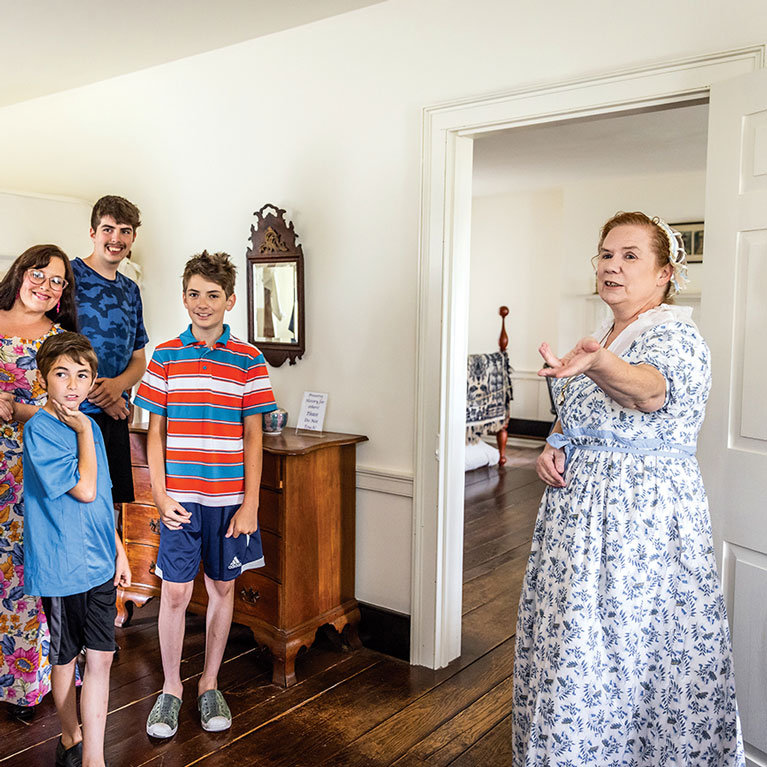

Picture it: 1815 Ohio. The state was only 12 years old. The War of 1812 was coming to an end. In the western Ohio wilderness, right at the edge of the United States and the Indiana Territory, a modern and unique three-story home and farm is constructed: the Johnston Farm and Indian Agency.
“People had never seen a place like this,” says Andy Hite, Johnston Farm and Indian Agency former site manager. “A big, brick High Federal-style house in the middle of nowhere.”
The farm was home to John Johnston, a trader-turned-Federal Indian Agent who fell in love with the area while riding through with General “Mad” Anthony Wayne’s Legion of the United States. Johnston’s career and family would eventually lead him back to the Great Miami River area where he played a significant — and oft-overlooked — role in Ohio’s story. “This was a place that saw history happen all around it,” says Hite.



The history of the land dates back to when the first prehistoric cultures migrated into Ohio, but this story begins around 1747 when a group of Piankashaw Native Americans came to an already-existing village called Pickawillany to be closer to British traders and their goods. Since the French had laid claim to the land, trouble soon arose and the French and Indian War ignited.
Some 45 years later, young John Johnston arrived, bringing supplies to Wayne’s Legion and camped there just before the Battle of Fallen Timbers. In 1802, Johnston was in the area now known as Fort Wayne, Indiana, and was appointed a trader at the Fort Wayne Agency. A few years later, Johnston resigned his post at Fort Wayne and, alongside his wife Rachel, moved to what he called his Upper Piqua Farm and began working at the area’s Indian Agency.
Johnston’s new home and the Agency were some of the last touchpoints of the American government in the West and were at the center of important events throughout the War of 1812. His positive relationship with Native Americans made him a great fit for the job. “He appreciated Native culture and Rachel was a credit to that — she took off his rough edges and realized the value of the different cultures,” says Hite, adding that Johnston had the ears of those in high places. “When he talked, everybody listened.”
Johnston served as an agent for just over 30 years, establishing a trustworthy reputation with a number of local tribes and playing a crucial role in helping to keep the peace during the stormy years during the War of 1812. “He made a hugely overlooked contribution to history,” says Hite.
After being let go from his job by Andrew Jackson due to political differences, Johnston’s next chapter of life began, and living on the literal edge of the frontier inspired him to develop the land for farming, trade and more beyond Piqua.
“He’s Ohio’s Thomas Jefferson — he did a little bit of everything,” says Hite. “People came to him to get stuff done.” Johnston joined the Ohio Canal Commission and contributed to the development of the Miami & Erie Canal (which, not coincidentally, passed right through his own front yard). He was also passionate about education and helped found Kenyon College, the state’s oldest private higher-education institution, and alongside Rachel, established the first Sunday school in the area.
Over the course of their 38-year marriage, Johnston and Rachel had 15 children. When Rachel died in 1840, Johnston left the farm to live with his daughter in Cincinnati. Johnston passed away in 1861 at age 86, just one month before the U.S. Civil War broke out.


As for the house and farm, the property fell into disrepair and was in poor shape when it was acquired by the state in the 1960s to be turned into a historical park. The home was gutted for a full renovation in the 1970s, which likely saved its crumbling bones, but didn’t preserve the original style and decor. Luckily, original pieces including the ornate mantle and decorative woodwork were saved.
In 2018, a new renovation aimed to restore the home to its former glory. Restorers conducted extensive research, including through family letters and even analysis of paint layers on original wood, and developed a clearer picture of what the original interior of the home looked like. Completed in 2022, Hite says he’s sure the Johnstons would immediately recognize the renovated site as their home.
In addition to the renovated house, the farm also features a museum, historic barn, springhouse and a recreation of Johnston’s cider house. Visitors can also see an on-site Adena mound and earthwork and take a ride on a mule-drawn canal boat.
Be sure to check the Farm’s calendar for special events, including History Alive living history weekend in July, Evening on the Canal in August and Christmas at the Johnston Farm in December.
Built in 1791, this fort originally served as a supply depot and was the site of several sieges during the Northwest Indian War.
Tour the site of the “last battle of the American Revolution” that led to the opening of the Northwest Territory.
Once part of the Miami & Erie Canal, these locks opened in 1845 and helped transport people and goods by boat from Lake Erie to the Ohio River for nearly 70 years.
Two major frontier battles between the U.S. Army and an alliance of American Indian tribes took place on this site in the 1790s.
Built just a few years before Johnston’s farm, this historic homestead was the childhood home of John Patterson, founder of Dayton’s National Cash Register company.